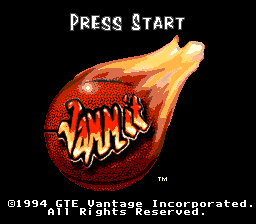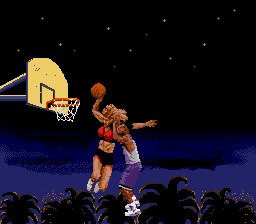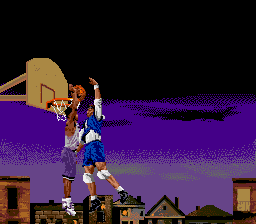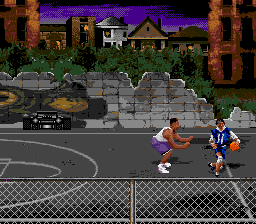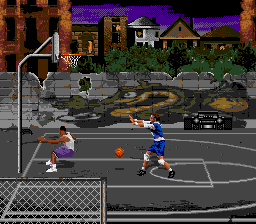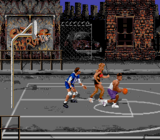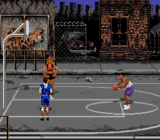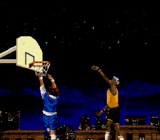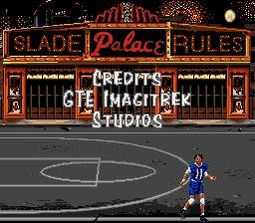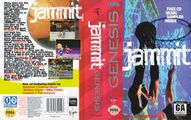Jammit
From Sega Retro
| Jammit | |||||||||||||||
|---|---|---|---|---|---|---|---|---|---|---|---|---|---|---|---|
| System(s): Sega Mega Drive | |||||||||||||||
| Publisher: Virgin Interactive Entertainment | |||||||||||||||
| Developer: GTE ImagiTrek | |||||||||||||||
| Sound driver: GEMS | |||||||||||||||
| Genre: Sports (basketball) | |||||||||||||||
| Number of players: 1-2 | |||||||||||||||
| |||||||||||||||
|
Jammit is a 1994 basketball game for various consoles, including the Sega Mega Drive, by GTE ImagiTrek Studios (renamed GTE Interactive Media shortly after the Mega Drive version's release). This version was published by Virgin exclusively in the United States.
Jammit was previewed for release in Europe around March 1994[2], and was also advertised for release in Japan in July 1997 (at a price of ¥8,900), but neither version materialised.
Contents
Gameplay
The game is a one-on-one basketball game starring several fictional street-smart players. Matches are held on street courts with a single basket, and they are all played up to a certain score, with no timer. Shots from outside the painted line are worth two points; any other shot is worth one point. Jumping close to the basket changes the view to the "Slam Cam," a zoomed-in view that highlights slam dunks. Players can play as Chill, who has the best defense near the basket and the best slams; Roxy, who is the best long shooter because of her high jump height; or Slade, who is the fastest player.
Players move around the court with the D-Pad. Players become fatigued as the game goes on, but they can energize by "pumping up" three times a game by pausing the game with START and selecting "Pump Up." Some play modes allow fouls, but others give the fouled player a free throw.
In single-player games, the player chooses a character and progresses through eight different play modes. The player starts with $300 to wager against an opponent with the same amount, with matches continuing until one contestant is out of cash. The player can choose to wager the full amount to defeat the opponent in only one game, which causes the opponent plays more aggressively, or to wager only $100 or $200. When an opponent is defeated, the player proceeds to the next play mode, which has different rules, and wagers against another opponent. After completing all of the modes, the player faces the Judge, a difficult opponent who chooses his own set of rules. There is a password system for continuing.
In two-player games, two players choose different characters, any play mode (except Cutthroat), and any court (except the Palace and the Cutthroat Court). There is also a demo mode where two computer-controlled opponents play any mode (except Cutthroat).
Modes
In single-player games, the order in which the modes are played varies somewhat depending on which character is selected, though they all start with 1 on 1 and end with the Judge.
- 1 on 1: A normal one-on-one round with fouls enforced and loser's outs (the opposing player gets the ball after scoring). First player to 21 points wins.
- Sweat: A more intense one-on-one round with no fouls and winner's outs (the player retains possession of the ball after scoring). First player to 21 points wins.
- 2 Hot: A one-on-one round with fouls enforced and loser's outs. A "hot spot" (a large X) moves around the court; making a shot while standing on the hot spot is worth double the points. First player to 21 points wins.
- Poison: A one-on-one round with fouls enforced and loser's outs. First player to 21 points wins, but if the player attains the "poison" score of 20 points, the player's score is reduced by 10 points.
- Slams Only: A one-on-one round with no fouls and winner's outs. Only slam dunks count in this mode; all other shots miss. First player to 10 points wins.
- In 2 It: A one-on-one round with fouls enforced and winner's outs. Two hot spots move around on the court; making a shot while standing on the hot spot is worth double the points. First player to 21 points wins.
- Frenzy: A one-on-one free-for-all with no fouls. There are two balls and no outs after making a shot. Two hot spots move around on the court, and shots can only be made when standing on a hot spot. First player to 10 points wins.
- Cutthroat: This mode is only played in single-player games. It is a three-player mode with one ball. After each basket, the scoring player gets a free throw. The ball is back in play after the throw, and anyone can take it. First player to 21 points wins, but if the player attains a score of exactly 13 or 20 points, the player's score is reduced by 10 points. The wager for this mode is set at $600.
- The Judge: This mode is played in single-player games after winning all of the other modes. The player faces the Judge, a fast and aggressive opponent, at the Palace, his home court. The rules are set by the Judge and differ with each playthrough, and the wager is set at $3,000 (the player's entire pot at this point).
Production credits
- Director: Paul Rhoads
- Software Design: Phil Sorger, Bob Skinner
- Exec Producer: Tom Casey
- Producer: Jerry Albright
- Art Director: Lori Nichols
- Graphic Artists: Brian McManamon, Jenifer Bacon, Mark Macy, Susan Hayden
- Music: Doninique Widiez, Dwight Stone
- Music & SFX Editor: Terry Barnum
- Production Mgr: Stephanie Koerner
- Quality Assurance: Stewart Spilkin
- Starring: William S Beckles, Josef Cannon, Joni Davis, Jonathan Yacker
- Special Thanks: Danny Aijala, Dane Wygal, Dan Spirn, Dale Marvin, Tommy Tallarico, Joe Kosic
- Quality Assurance: Bijan Shaheer, David Fries, Paul Moore, Erik Harshman, Nick Camerota, Mike McCaa, Chris Rausch, Scott Manning
- Producer: Michael S Glosecki
- Asst Producer: Ken Love
- Dir of Software Publishing: Neil Young
- Manual: Russ Ceccola, Lisa Marcinko
- Box: Lauren Rifkin
Magazine articles
- Main article: Jammit/Magazine articles.
Promotional material
Physical scans
| Sega Retro Average | ||||||||||||||||||||||||||||||||||||||||||||||||||||||
|---|---|---|---|---|---|---|---|---|---|---|---|---|---|---|---|---|---|---|---|---|---|---|---|---|---|---|---|---|---|---|---|---|---|---|---|---|---|---|---|---|---|---|---|---|---|---|---|---|---|---|---|---|---|---|
|
| 69 | |
|---|---|
| Based on 10 reviews | |
Technical information
- Main article: Jammit/Technical information.
References
- ↑ 1.0 1.1 1.2 Game Players, "Vol. 7 No. 5 May 1994" (US; 1994-0x-xx), page 62
- ↑ Sega Magazine, "January 1994" (UK; 1993-12-10), page 26
- ↑ File:Jammit MD credits.pdf
- ↑ VideoGames, "July 1994" (US; 1994-0x-xx), page 75
- ↑ GamePro, "July 1994" (US; 1994-xx-xx), page 19
- ↑ EGM², "July 1994" (US; 1994-07-19), page 57
- ↑ 1700 igr dlya Sega, "" (RU; 2001-xx-xx), page 102
- ↑ Electronic Gaming Monthly, "February 1994" (US; 199x-xx-xx), page 40
- ↑ GamePro, "February 1994" (US; 199x-xx-xx), page 134
- ↑ Game Informer, "March/April 1994" (US; 1994-0x-xx), page 32
- ↑ Hyper, "May 1994" (AU; 1994-xx-xx), page 42
- ↑ Sega Pro, "May 1994" (UK; 1994-04-21), page 42
- ↑ Todo Sega, "Abril 1994" (ES; 1994-0x-xx), page 38
- ↑ Tricks 16 bit, "Tricks Sega Gold 800 igr" (RU; 1998-03-20), page 93
- ↑ VideoGames, "June 1994" (US; 1994-0x-xx), page 87
| Jammit | |
|---|---|
|
Main page | Development | Magazine articles | Reception | Region coding | Technical information | |
